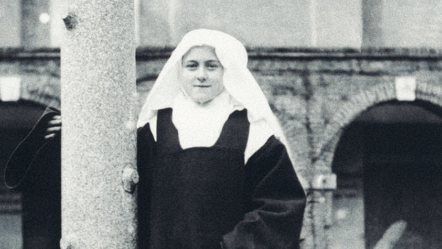Lent is upon us. Many take the opportunity to grow closer to our Lord by taking on extra penances, fasting a little more often, or perhaps allotting additional time for prayer and devotion. Lenten practices are meant to establish more permanent spiritual habits that will continue long after the celebration of the Easter Vigil. Turning toward St. Therese, the Little Flower, can yield an abundance of spiritual fruit and instill lifelong habits, responding to the invitation of Jesus, “for everyone who asks, receives; and the one who seeks, finds; and to the one who knocks, the door will be opened.” (Mat 7:8 NAB)
Penance
St. Therese, in her “Autobiography of a Soul” had much to say regarding acts of penance. “I did not realize in those days that one had to go through much suffering to become a saint.” She was aware of the call of Jesus,“If anyone wishes to come after me, he must deny himself and take up his cross daily and follow me” (Luke 9:23 NAB) and knew the powerful effect of offering suffering to Jesus for personal and other’s benefit; “I know that Jesus cannot want us to suffer uselessly.” She remarked“Carmelites should save souls by prayer.”
For Therese, one does not need to search out additional crosses to bear. “Mortifications over and above those which came her way in the normal exercise of her duties were not for her.” Therese, in what has become known as the “Little Way”, understood that God will send the crosses He knows are needed and she accepted what came to her each day as God’s will. She acquired the habit of greeting painful and repugnant things with a smile. “I have always forced myself to love suffering and to welcome it joyfully. Little crosses give me more joy than anything else”. In her own way, Therese relied always on God’s providence and strength. “Every moment He sends what I can bear and no more.”
“I am too little to ask for greater suffering, having chosen it myself I should have to bear it myself, and I have never been able to do anything by myself.” The wisdom of the Little Way of St. Therese makes holiness accessible to everyone. Relying on God to work in His way, in His time, not forcing one’s own idea of holiness upon God can bring peace of mind to the daily struggle to do God’s will.
How can this little way be applied as a practice for Lent? Like Therese, we can be conscious of the crosses we are sent each day and join them to the cross with Jesus. St. Paul makes the connection. “Now I rejoice in my sufferings for your sake, and in my flesh I am filling up what is lacking in the afflictions of Christ on behalf of his body, which is the church,”(Col 1:24 NAB) St. Paul teaches we are joined to Christ as members of His body, our sufferings are joined with His and we participate in the redemption of ourselves and the world. Through the Sacrament of Baptism, the new Christian becomes priest, prophet and king. The role of a priest is to offer sacrifice, and offering up sufferings, joining them to the sufferings of Christ, the priestly office is fulfilled. Perhaps during lent, like Therese, one need not seek out additional crosses but be open to more fully appreciate and bear those crosses God has chosen which, in His way, are what is best for the soul today.
Taking a few moments each day during Lent to reflect on these gems of spiritual wisdom from St. Therese can help instill in the heart the “Little Way” and draw the soul closer to the Lord.
“The More personal the suffering, and the more hidden from the eyes of the world, the more pleasing it is to You, my God.”
“I can only offer very little things to God. These little sacrifices bring great peace of soul.”
“How very good God must be to give me strength to bear all I endure.”
“He did not send me this heavy cross until I could bear it.”
“Every moment He sends what I can bear and no more.”
“O God, how good Thou are to temper every trial to our strength.”
“He alone, content with my frail efforts, will lift me up to Himself, clothe me with His own merits and make me a saint.”
Prayer
Lent is a time to foster growth in relationship with the Lord. Prayer is communication with God. Communication is essential to growth in any relationship. The more communication the deeper and stronger will be the roots of the relationship. Satan is well aware of this need for communication, and he lays a “Lenten Trap”.
More prayer is better, Satan insists, lying with the truth. For Lent, why not add another devotion or two or three to already busy days. Satan knows that doing so will cause fatigue, feeling guilty if one of the new devotions is neglected, whispering in the ear Satan lays his trap, “see, you are not worthy, you cannot keep up with the saints, why bother? Holiness is not for you.”
St. Therese, in her Little Way, has the remedy for Satan’s deadly trap. Reflecting on the life of prayer St. Therese admits, “The daily recitation of the Divine Office is a great joy to me in spite of my unworthiness, but apart from this I have not the courage to make myself search for wonderful prayers in books; there are so many of them and it gives me a headache. In any case, each one seems more beautiful than the one before. As I can’t say all of them, and do not know which to choose, I just act like a child who can’t read; I tell God, quite simply, all that I want to say, and He always understands.”
Such wisdom! Rather than adding additional devotions, spend more time and practice fewer devotions more fervently. Is it better to do many devotions poorly or be more deeply immersed in one or two? What devotion speaks to the current circumstance of life? Do not fall into the trap. As the psalmist instructs, “O Lord, my heart is not proud, nor haughty my eyes. I have not gone after things too great nor marvels beyond me. Truly I have set my soul in silence and peace. As a child has rest in its mother’s arms, even so my soul.” (Ps 131) For Therese, the depth of prayer was found in simplicity. “Prayer, for me, is simply a raising of the heart, a simple glance towards Heaven, an expression of love and gratitude in the midst of trial as well as in times of joy.”
In her “Little Way”, Therese provides the map along the path towards a truly fruitful Lent. Perhaps Lent is not about giving up and doing more, but being more attuned to how God is at work in the soul. Focusing attention on where God is working in the ordinary circumstance of everyday life; paying attention to the daily little crosses or even the big heavy crosses God sends, knowing that being immersed in that moment, one need not seek a cross God did not intend to give. Praying fewer devotions well instead of many devotions poorly, being attuned to God’s movement in the soul. Simply being aware of God’s presence in the every-day moments of life. Therese observed “The closer we come to God, the more simple we become. Perhaps Lent is more about tuning into where God already is instead of seeking Him out in yet another devotion or book.
+++
All quotations are taken from “The Autobiography of Therese of Lisieux, The Story of a Soul” Dover Publications, Inc. Minelola, New York, 2008.








